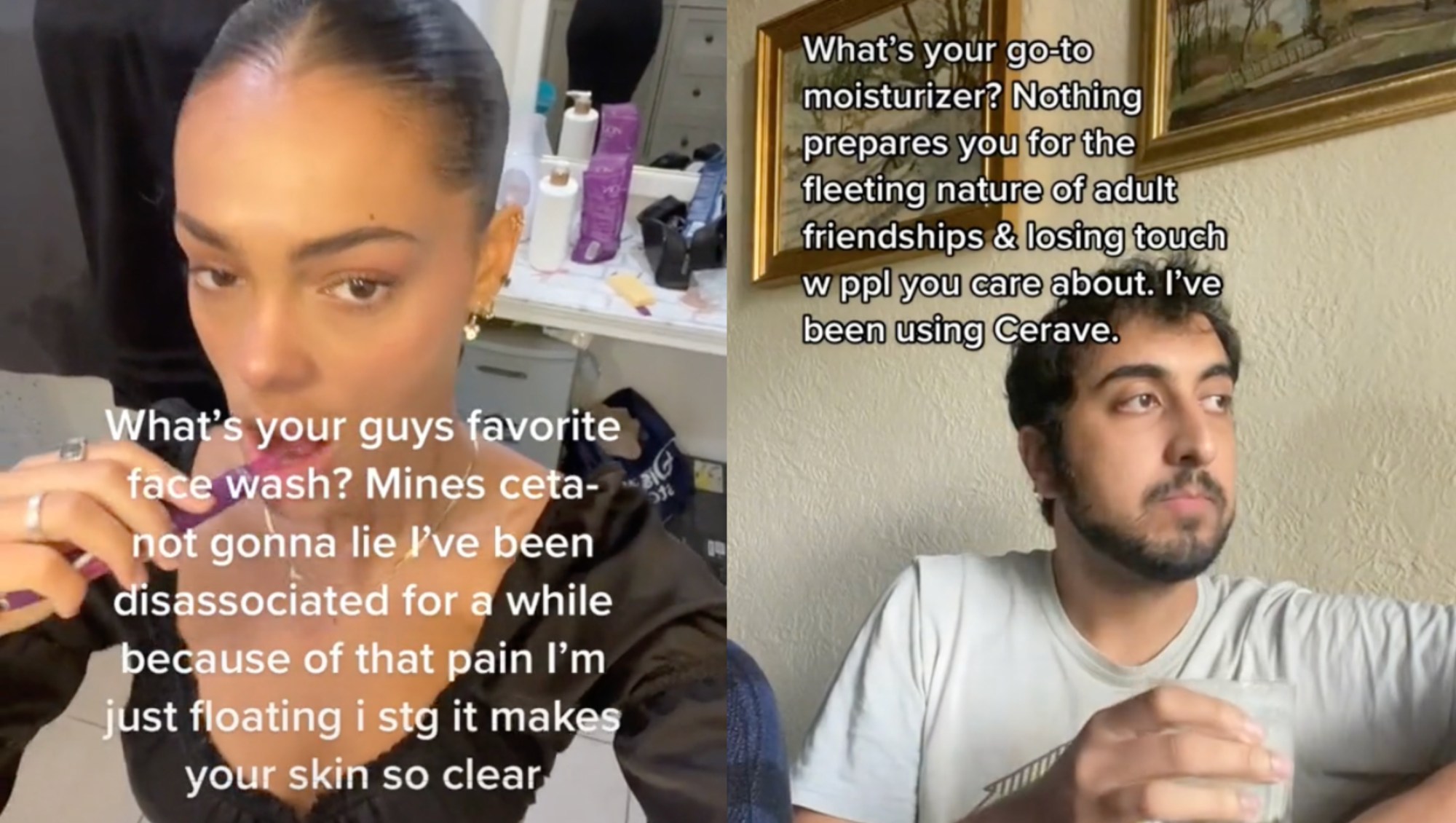In 2019, there was a trend on Twitter where women would hide messages from straight men through the guise of “makeup suggestions.” The format was used mostly for humorous dating advice, but sometimes the question of “Sephora or Ulta” might be followed by more serious discussions of gender pay equity (users telling fellow women to “rob him”) or women’s safety (encouraging ladies to carry weapons for protection). “Skincare chat! I’ve recently been using this spray-on sunscreen by Vichy and I have to say, no ashy payoff at ALL okay they’ve stopped reading. what are your favorite lies to tell men about what you do for a living? I like to tell them I write about fashion and makeup #skin 💕,” Tweeted Chidera Eggerue British aka The Slumflower.
This year, a similar trend has circulated on TikTok, with beauty creators sharing their unfiltered thoughts amongst beauty enthusiasts through the guise of makeup recommendation videos. “What’s your favorite face wash? Mine’s Ceta- I’m not gonna lie I’ve been disassociating for a while because of that pain I’m just floating I stg it makes your skin so clear,” wrote one creator on a viral video. This time, however, the format has evolved from being a space for non-men to candidly discuss men to a place where far more personal and existential conversations are happening online. The act of watching makeup videos has always been somewhat therapeutic, and this trend holds up the unspoken internet rule that tutorials provide a safe space to talk about feelings online.
If you’re on #beautytok, you’ve seen videos where creators do their makeup to the soundtrack of a personal story. With content like this, traditionally feminine interests like makeup go far beyond the lack of depth they’re often critiqued for and are an integral part of building connections for a number of communities. For 37-year-old beauty expert David Lopez, this is in large part due to beauty routines being inherently intimate. “I think beauty routines are always a moment of self-reflection for a lot of people, whether or not they realise it,” they say. “There aren’t many intimate moments in our life anymore that are not public to everyone. So I think that that’s why beauty is the go-to space for these kinds of discussions.”
David believes some beauty videos that are purposely “hiding” messages from men may be well-intentioned, but they can feed into misogynistic and patriarchal ideas around beauty. “I have a large online community and my videos spark discussions with all kinds of people, including cis men who identify as straight,” they say. “I also get all kinds of messages from cis women saying my content empowers them to have conversations with their sons, partners or friends, or from people in my own community, who are assisting gay men who have squashed their inherent feminine qualities because we wanted to fit in so badly and be seen as sexually or socially viable — which meant being as masculine as possible.”
David’s own exploration into gender expression started through exploring wigs and makeup through their content and blog Groom and Comb. Showing their journey in real-time on TikTok, from someone who lied about wearing under eye concealer to one perfecting full faces of makeup, he says the beauty space online is extremely democratized. “Everyone has some sort of access because there are so many touch points,” they say. “And people have a deep connection to it because it’s personal. Someone who doesn’t feel like they have a community of like-minded people around them in real life might find that online. To me, it’s similar to the gaming community.”
Another TikTok beauty creator Ariam, a 24-year-old based in Washington, D.C., says one of the key reasons that beauty content has become a safe space for many online is because of self-expression. “I would describe beauty as being a form of self-care and to some, including myself, it goes past looking good externally,” she says. “The process of sitting down at my desk and putting on makeup is how I like to re-centre myself for the day. That’s time that I’ve reserved especially for me, in a space where I feel safe and neutral. Putting on my makeup gives me the grace to reflect on myself and make sure I’m not neglecting myself and my feelings.”
Of course, the beauty industry at large and many beauty communities online are still rife with bigotry, pushing transphobic, racist or fatphobic ideals. This is particularly prevalent in beauty advertisements, where models are still predominantly thin, young and white. With this in mind, Ariam recommends those looking for connections in the beauty community be aware of who they’re opening up to. “Most people have good intentions, are rooting for you in all aspects, and will make you feel comfortable opening up and expressing yourself on a different level, but just like in any other scenario you want to be mindful,” she says. Ariam often gets messages asking for makeup and hair advice. “Like myself, people are relearning what they like from scratch and sometimes you need guidance through that.”
From the 2019 Twitter format to today’s existential TikTok makeup confessions, it seems time and time again that beauty recommendations and makeup videos have become a place to discuss our true feelings. And with the abundance of self-promotion and professional content online, perhaps it’s one of the few spaces left. Far from being frivolous, whatever gets people talking to each other about loneliness, friendships, fears and personal issues is worthwhile. If you need a makeup brush in your hand to do so, then so be it.


